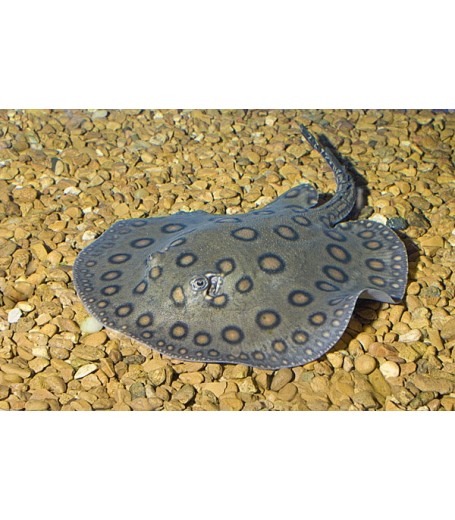STINGRAY MOTORO
- RM0.00
Rays are relatives of sharks and sawfishes, which have a skeleton that differs from the one that ordinary fishes have, since it doesn’t have bones, and it completely consists of cartilageous tissue.
The scientific name of this kind is an ocellate river stingray, which means that the ray can sting. Really, the ray has a poisonous spine on its tail (actually, it used to be a scale once). The ray uses this spine to protect itself. The poison is produced by the glands located near the bottom of the spine.
Contrary to common belief, rays don’t attack humans with their spines. You should step on one of them or disturb somehow to make the fish sting you.
Motoro stingray loses its spine occasionally (every 6-12 months), and you can find it on the bottom of the tank. This is a normal situation, and it shouldn’t bother you.
Another feature of freshwater rays is the ampullae of Lorenzini. This is a special tube or channel located on the fish head (around its eyes and nostrils).
Using these, cartilaginous fishes detect electric fields, and they help them to navigate according to the terrestrial magnetic field.
In the wild, stingray is up to 50 cm large in diameter and up to 1 m long. It weighs up to 35 kilos. When keeping it in the tank, the fish, of course, doesn’t grow that large.
Habitat
This kind is quite widespread in South America. The ocellate river stingray is also encountered in Columbia, Peru, Bolivia, Brazil, Paraguay, and Argentina. Motoro stingray inhabits both Amazon River and its tributaries: Orinoco, Rio-Branko, Parana, Paraguay rivers.
Like other representatives of the kind, the fish is encountered in different biotopes. Mainly these are sandbanks of large rivers and their tributaries where the substrate consists of mud and sand.
Keeping in a tank
Freshwater rays are very sensitive to ammonia, nitrites, and nitrates content in water, that’s why it is important to have an understanding of a nitrogen cycle and keep the tank water crystal clear.
The latter is quite a challenging task since rays produce a large amount of ammonia. Large-sized tanks, efficient biological filtration, and regular water renews – is the only way to keep the proper tank and water conditions.
Most freshwater rays can be kept in a tank at PH from 6,8 to 7,6, alcalinity from 1° to 4° (from 18 to 70 ppm) and water temperature from 24 to 26°C. Ammonia and nitrites level should be zero, and nitrates level should be lower than 10 10 ppm.
In terms of the tank size for rays, the following approach works best – the larger, the better. The walls height is not a crucial parameter, but the tank should be from 180 to 220 cm long and from 60 to 90 cm wide to keep a ray in it for a long time.
A tank from 350 to 500 liters capacity will do to keep young rays in it, but for a long-term keeping of adult species, you will need a tank not less than 1000 liters large. Small-grained sand can be used as the tank substrate.
Feeding
Freshwater rays are flesh-eaters that feed mainly with fish and crustaceans in the wild. These are active fishes with high metabolism level, and that’s why you should feed them at least twice a day.
They are also known as gluttonous ones, thus the food for them will be quite costly for you. In general, the motoro stingray diest should be natural, though some may eat artificial food.
Young species eat live or frozen blood worm, tubifex, brine shrimps, prawns, etc., while adult ones should be fed with the food of larger size. It can be whole mussels, shellfishes, prawns, calamaries or fish juveniles (or some other fresh fish), and earthworms. Diverse diest is a must to keep the motoro stingray in its best condition.
Tank mates
Rays spend most of their time on the bottom. Their eyes and branchial apertures are on top of the body, which allows the fish to spend time under the sand waiting for food. They have perfect eyesight, and they jump out of the sand to catch their prey.
Other kinds of rays will be the best tank mates for stingray. Although Cichlasoma severum, Geophagus, silver arowana and Polypterus species will also do as stingray tank mates.
Rays are one of the main predators in ecosystems where they dwell in the wild, and it’s not safe to keep them together with most of the other fish kinds in a tank. Their tank mates should be large enough not to become food for them, but peaceful enough as well not to bite rays or steal their food.
Thus, fish that swims in upper and medium water layers will be the best choice in this case. I’d advise avoiding armored catfishes as rays tank mates, since there are a lot of documented reports saying that they get stuck to rays and damage their skin.
Gender differences: male vs female
Female species are larger than males, and they have two uteruses, which means that they can have offspring from two different males simultaneously. Males have modified fins that they use to fertilize the females.
Reviews
There are no reviews for this product.



